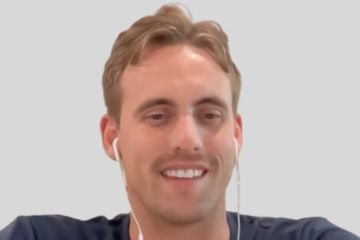From Model to Menswear Founder

Weston Jon Bouchér is a California-based menswear brand and the name of its founder. He launched the company in 2019 after a decade as a full-time apparel and lifestyle model.
He initially sought a white-label supplier with like-minded quality standards. Unsuccessful, he opted instead for “cut-and-sew manufacturing.” The result is a network of global manufacturers, all producing apparel to Weston’s designs and specifications, and sold entirely from his Shopify site.
In our recent conversation, he addressed the brand’s launch, production challenges, marketing tactics, and more.
Our entire audio is embedded below. The transcript is edited for clarity and length.
Eric Bandholz: Who are you?
Weston Bouchér: I’m a menswear designer based in San Diego. My background spans music and photography, but for the past six years, I’ve worked full-time on my self-named menswear line. I also run a YouTube channel focused on self-improvement, style, and grooming, drawing on my 10 years as a full-time model.
That modeling experience exposed me to a range of designer brands and fabrics, which sparked the idea to create my own line. I wanted to offer staple silhouettes — evergreen pieces that feel stylish year after year, not just trendy. I couldn’t find a white-label supplier that fully aligned with my standards, so I opted for cut-and-sew manufacturing instead.
If I could go back, I might simplify things. But my perfectionism and desire to fill a gap in the market — quality luxury basics at a fair price — pushed me to build something unique. I launched with just five core styles inspired by pieces in my wardrobe, each thoughtfully refined for fit, fabric, and longevity.
Bandholz: What’s your approach to design?
Bouchér: Initially, I was solving my own problem. I wanted a one-stop shop for staple pieces, but I found most brands lacked consistent fit, often chasing trends. Oversized styles are big now, but I’ve always preferred a slimmer, more timeless European look. It suits me better, so I became the fit model for my brand. I work closely with my developer, adjusting every sample down to the millimeter.
Being a slim-fit brand increases return rates since people fall between sizes. Artificial intelligence could help in the future, but for now, I constantly analyze reviews and return data to refine the fits. It’s one of the most complex aspects of running a lifestyle apparel brand, especially when working with manufacturers worldwide. Every fabric, every factory requires precise tech packs to ensure consistency. I’m obsessive about quality. Even the most minor issue drives me to tweak endlessly.
That’s why starting with something simpler, such as hats or underwear, might have made sense. But I’m in it now. I aim to simplify the customer experience: fewer options, better fabric, timeless silhouettes — polos, crewnecks, cardigans, denim, swim trunks — clothes guys can count on, without sacrificing comfort or style.
Bandholz: Tell us about your team.
Bouchér: In the first couple of years, it was mainly me. As the budget allowed, I gradually added to the team. Today, I work with 11 contractors, most of them fractional. The only near full-time staff are at our San Diego warehouse, where two to three people handle pick-and-pack and inventory management.
My goal is to stay lean and keep as much as I can under one roof, so when it’s time to scale, it’s just about adding capital and expanding distribution.
On the manufacturing side, I now work with 10 to 12 partners globally — two in Los Angeles, and others in Bangladesh, Thailand, and China. I used to work with a factory in Colombia, but that relationship ended. Manufacturing in the U.S. was always my goal, but the development costs made it nearly impossible early on. Now that I’ve grown, I’m revisiting that.
Margins are tricky with overseas production due to constantly changing tariffs and shipping costs. I started the brand in 2019 after attending the Sourcing at Magic textile show in Las Vegas, where I met manufacturers face-to-face. That experience gave me the confidence to go all in. Most factories require a minimum order of 2,000 to 4,000 units per style or color, which is tough when you’re starting. I got lucky. One manufacturer agreed to work with me on just 300 to 600 units. That deal is what made the brand possible.
Bandholz: What’s the long-term vision for the brand?
Bouchér: For me, it’s about building the lifestyle I’ve always wanted — more time with friends and family, travel, and a comfortable way of living. That’s not easy in Southern California with the high cost of living and the tax burden of running a business.
I want the brand’s legacy and mission to stay intact. I’ll never cash out and walk away — my name is on it, and I take pride in that. When customers leave positive reviews and share their love for the product, that’s the most rewarding part for me. I want to keep delivering that feeling of quality and care.
Ideally, I’ll remain self-funded. That way, I keep full control, especially when it comes to product integrity. I genuinely believe the reason we’ve grown so strongly is that I’ve paid close attention to the details. Good marketing can sell anything once, but getting someone to come back because they trust the product is where it matters.
Long-term, I hope to step back from day-to-day tasks and transition into a more visionary and creative oversight role — still involved in design, but with a greater focus on the brand’s image. Right now, my biggest motivation isn’t money — it’s quality of life. So I’m constantly thinking about who I can bring in to help me reclaim more of my time, while keeping the brand aligned with what made it special in the first place.
Bandholz: Is YouTube your primary marketing channel?
Bouchér: We’re not in physical stores. We sell directly from our Shopify-powered website. In the first year, YouTube was key. I used it to test the waters, and my male viewers were constantly asking style-related questions, which sparked the idea for the brand. I launched and got great feedback quickly, thanks to that audience. But as the brand grew, I had less time to make videos. I stopped posting regularly for over a year, and though I’ve picked it back up, it’s been a missed opportunity, primarily due to a lack of time.
After that first year, we pivoted to Meta ads. That’s now our primary driver for traffic and sales. I’m not using an agency. We’re running lean, and the numbers have been substantial, especially compared to what I hear from other brands. I’ve taken out a few loans for inventory, but we’ve managed to make it work without investors.
TikTok shifted the landscape. People want content that feels real, not overly produced. Some of our best-performing ads feature me in my bedroom, talking through different looks. The conversions have been great, and we’ve learned that simple, authentic content outperforms polished productions.
Bandholz: Have tariffs taken a toll?
Bouchér: I’ve learned not to be reactive, whether it’s personal challenges or business volatility like tariffs. I focus on what I can do each day. When the tariff situation heated up, I didn’t panic — I’ve been preparing for this. Even before it started, I told my developer we couldn’t rely too heavily on China. I had a gut feeling that this would become an issue, and I wish I had diversified even more back then.
Some of our manufacturing partners have had to add surcharges due to duties, which is tough. I value those relationships and won’t abandon them over short-term pressure — we’re all navigating this together. That said, I do have a backup plan. I’m looking at producing top-selling styles elsewhere if needed. But for now, I’m waiting, watching, and staying ready. Trade dynamics change daily. The best move is to remain flexible and strategic, not reactive.
Bandholz: Where can folks buy your clothes or reach out?
Bouchér: Our site is WestonJonBoucher.com. I’m @WestonBoucher on YouTube and LinkedIn.









